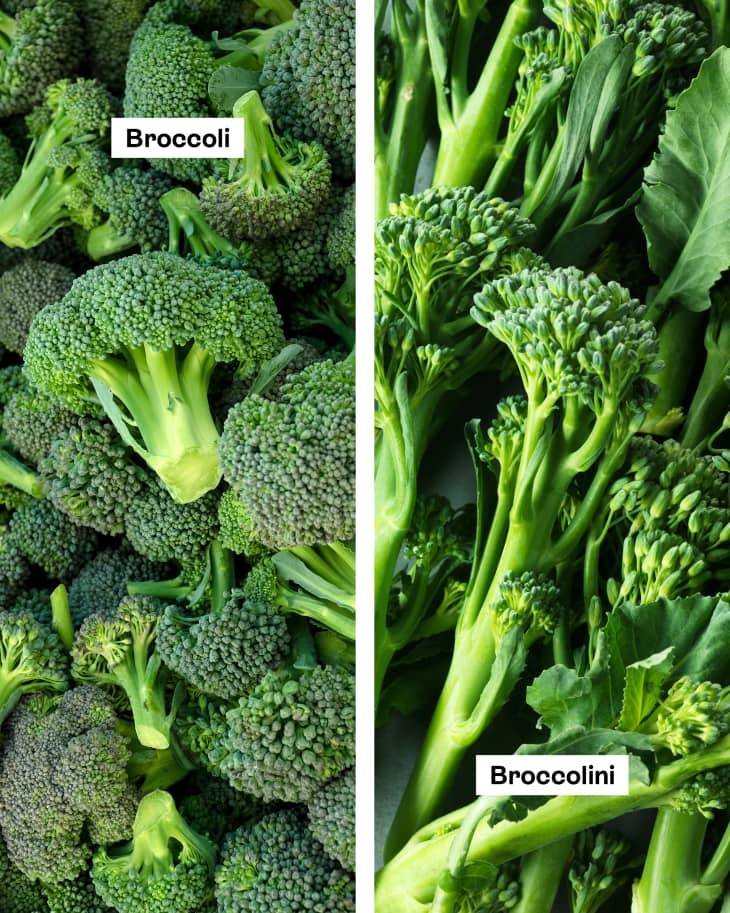What’s the Difference Between Broccoli, Broccolini, Broccoli Rabe, and Chinese Broccoli?
If you’ve set a goal to include more greens in your diet, these four winter greens are a good place to start. While they all come bearing firm stalks topped with deep-green leaves and florets, do you really know what sets broccoli, Broccolini, broccoli rabe, and Chinese broccoli apart?
The Difference Between Broccoli, Broccolini, Broccoli Rabe, and Chinese Broccoli
Despite their similar names, what sets these winter veggies apart is the plant family they belong to. While broccoli, Broccolini, and Chinese broccoli are closely related to cabbage, the closest kin to broccoli rabe is turnips. A closer look at the size of their stalks, along with their leaves and florets, illustrates their differences.
More About Broccoli
With thick, crisp stalks topped with rounded green florets, broccoli is a member of the cabbage family. It has a grassy, earthy flavor that’s mildly bitter. And while we most often reach for the florets, the whole plant is edible. Additionally, there are many different ways to cook broccoli at home.
This green veggie is super versatile when it comes to cooking. Steamed, sautéed, roasted, stir-fried, or even puréed into a sauce — pick your favorite, and have at it. And while it makes a good side dish when cooked, broccoli can easily be used raw in salads and crudités.
Recipes Using Broccoli
What Is Broccolini?
Despite what you may have heard, Broccolini is not baby broccoli. This lanky vegetable is a hybrid first created in 1993. Broccolini a cross between broccoli and Chinese broccoli. It has small florets, long stalks, and a few small leaves — all of which are edible.
Compared to the bitter flavor of common broccoli, Broccolini is more mild, with a sweet, earthy taste. And while it can be eaten raw, Broccolini is best when cooked. It can be sautéed, steamed, roasted, and grilled.
Recipes Using Broccolini
What Is Broccoli Rabe?
Contrary to its name, broccoli rabe isn’t actually related to broccoli. Instead, it’s closely related to the turnip. And the best way to approach it is just as you would with bitter leafy greens, like mustard greens or turnip greens.
This long, slender vegetable, which may also be referred to as broccoli raab and is similar to rapini, has thin stalks with deep-green leaves and small buds that resemble broccoli florets. Broccoli rabe is sold fresh in grocery stores and farmers markets, and is at its peak in the cold months of winter.
Although the flavor mellows somewhat as it cooks, broccoli rabe has a bitter taste that’s also a bit earthy and nutty. It’s particularly popular in Italian cuisine, and best when sautéed or blanched to soften the stalks and leaves.
Recipes Using Broccoli Rabe
More About Chinese Broccoli
Chinese broccoli — also known as kai-lan, gai-lan, and Chinese kale — is a leafy green vegetable closely related to thick-stemmed broccoli, cabbage, and Brussels sprouts. It has flat leaves, thick stems, and tiny florets.
Widely eaten in Chinese, Vietnamese, and Thai cuisine, Chinese broccoli has a slightly bitter and earthy taste, and is best after a quick steam or sauté, or in a stir-fry. It may prove tough to find Chinese broccoli in large grocery stores, so check your local Asian market, which is more likely to carry it.
Can They Be Used Interchangeably?
The short answer is yes, but there are a few caveats.
Because they vary in size and shape, certain swaps work better than others. If you’re focused on florets, broccoli and Broccolini can easily be used interchangeably. If you’re cooking with the broccoli stalk, Chinese broccoli also has a thick stem and makes a good substitute. And if the leafy greens are what you’re after, broccoli rabe and Chinese broccoli can be used for one another. Do keep in mind that you may have to adjust the cook time to account for the swap.
